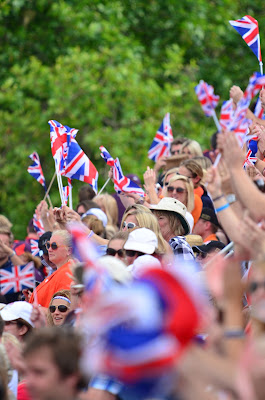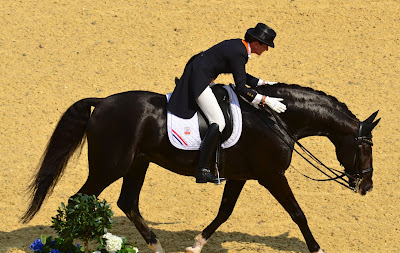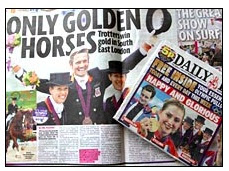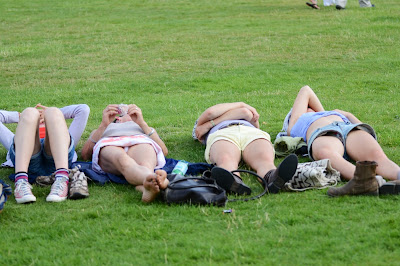 |
| History-making victory gallop: Team GB dressage gold medalists Laura Bechtolsheimer on Mistral Hojris, Charlotte Dujardin on Valegro, and Carl Hester on Uthopia. Photo by Jennifer Bryant. |
Those of us of a certain age remember a time when the thought of someone other than Germany or the Netherlands dominating dressage was unthinkable. Those nations were well-oiled machines that cranked out title after title--the headlines were continually dominated by Nicole, Isabell, Anky, Isabell, Anky--and seemed unstoppable.
The US began knocking on the door in the 1990s, earning a string of Olympic team bronze medals. But Great Britain? They weren't even taken seriously in the world of international dressage.
Well, the previously unthinkable happened today: Team GB won its first-ever Olympic dressage team gold medal (total team combined average score of the Grand Prix and today's Grand Prix Special: 79.979 percent), leaving in its wake silver medalists Germany (78.216) and bronze medalists the Netherlands (77.124). And Team USA? Sixth (72.435), behind Denmark (73.846) and Sweden (72.706).
For a while the US was keen to move up to the silver-medal spot on the podium; now I think we'd be happy just to get back on there again.
I don't mean to sound like Debbie Downer. I myself don't get too hung up on the "medal hunt," especially when horses, in all their unpredictability, are concerned. But after today, it's clear that the game has changed, and yesterday's stars don't quite measure up to today's.
 |
| Charlotte Dujardin and Valegro. Photo by Jennifer Bryant. |
The 2008 Olympic individual gold medalists, Anky van Grunsven and Salinero, looked outclassed among this new breed of horses and riders. Salinero has not diminished over time; rather, the new stars--Charlotte Dujardin's mount Valegro chief among them--have raised the bar. Horses like Valegro, Carl Hester's mount Uthopia, Helen Langehanenberg's Damon Hill, and Dorothee Schneider's Diva Royal show great expression, range of movement, collection, and brilliance
and relaxation, obedience, clear transitions, and suppleness. Gone is the brilliance fueled by tension. These horses still have plenty of spark; Diva Royal and Laura Bechtolsheimer's famously explosive partner Mistral Hojris got pretty wound up while their riders were on the medal podium, and during the victory gallop "Alf" looked more or less out of control. But they do not look that way in the arena.
 |
| Laura Bechtolsheimer and Mistral Hojris. Photo by Jennifer Bryant. |
The changing of the guard goes beyond Great Britain's ascendance of the dressage throne. The entire 2012 German team (Langehanenberg on Damon Hill, Schneider on Diva Royal, and Kristina Sprehe on Desperados) consisted of Olympic Games first-timers. And with the absence of 2010 World Equestrian Games gold medalist Totilas and current rider Matthias Rath, there was no pre-anointed German superstar, either.
 |
| German team silver medalists Dorothee Schneider, Kristina Sprehe, and Helen Langehanenberg. Photo by Jennifer Bryant. |
The one who stands to give the Brits the most competition in Thursday's Grand Prix Freestyle and individual medal final is Langehanenberg, whose Damon Hill, a Westfalen stallion by Donnerhall, has evolved from 2005 Five-Year-Old World Young Horse Champion to a supreme blend of athleticism and elegance. They earned a score of 78.937 percent for their effort in the Grand Prix Special today, behind Valegro (83.286), the Netherlands' Adelinde Cornelissen and Parzival (81.968), and Uthopia (80.571).
But back to the Brits. According to Carl Hester, the senior member of the team, "Hard work and dedication have paid off for all three of us." His own story is fairly well-known: Born in Sark on the Channel Islands, Hester began riding a donkey and moved to England at the age of sixteen to pursue a riding career. He spent many years in groom and apprentice-type positions, eventually working his way up to training, riding, and competing.
Dujardin, a former champion pony exhibitor, is Hester's protege and has trained with him for six years. "We are like a married couple, I guess; that's what everybody calls us," Dujardin said. "We do bicker. I shout at him; he shouts at me.
"I owe everything to Carl, really," Dujardin continued. "Training me, giving me fantastic horses to ride. He's very special to me."
The dressage world got acquainted with Bechtolsheimer when she and "Alf," a 1995 Dutch Warmblood gelding by Michellino, won team and individual silver at the 2010 WEG. The granddaughter of a billionaire German department-store-chain founder, Bechtolsheimer has had a more privileged entree to the horse world than her teammates. But it's clear that all are on equal footing when it comes to their riding and their horses.
"It was very emotional for me at the end of Charlotte's test when I knew that we'd done it," Bechtolsheimer said afterward. "It wasn't just about beating the Germans; it was about beating everybody else, which in Olympic history Britain's never done in dressage. To come here and win any medal would have been amazing, but to come here and win gold--I don't think it's sunk in completely yet. I think we're all really proud of each other and proud of our horses."
Although I'm sure the Germans and the Dutch are a teensy bit disappointed not to have won gold, I think I can safely say that everyone at Greenwich Park today was thrilled to see the fine British performances rewarded and to see the evidence that dressage excellence is expanding geographically. But I feel for Steffen Peters, Tina Konyot, and Jan Ebeling, who had one of those competitions when things just don't go the way one would like.
 |
| A happy Jan Ebeling waves to the crowd after his GP Special test on Rafalca. Photo by Jennifer Bryant. |
First to go for Team USA, Ebeling had a solid test with Rafalca to earn a score of 69.302 percent, putting them in 28th place individually, well out of the running for the GP Freestyle (only the top eighteen will advance). But he seemed genuinely pleased with his test on the steady fifteen-year-old Oldenburg mare by Argentinius.
"I was really happy with the horse; she went great, no real mistakes. She's been really good this whole week. She's given it all, and that's all I can ask," Ebeling said.
The "three amigos," as Ebeling called them--Rafalca's owners Amy Ebeling, Ann Romney, and Beth Meyer--were in the audience watching.
 |
| Steffen Peters and Ravel piaffe on center line. Photo by Jennifer Bryant. |
Steffen Peters' mount, Ravel, had an unfortunate stumble on the center line after the first canter pirouette that Peters said cost them a few points. "But I'm very, very happy with that," he said, referring to his score of 76.254, the highest US score, which tied Peters with Germany's Kristina Sprehe for seventh place individually and qualified him for the Freestyle.
"The half-passes felt great; I pushed the changes a bit more forward than the other day; the pirouettes felt really good," Peters said. "The piaffe even felt better than the first day. I'm just excited that he still wants to do it after all these years," he said of the fourteen-year old Dutch Warmblood gelding by Contango, owned by Akiko Yamazaki.
 |
| Tina Konyot and Calecto V in the GP Special. Photo by Jennifer Bryant. |
Of the US riders, only Peters will be riding in the individual medal final. Tina Konyot and her fourteen-year-old Danish Warmblood stallion, Calecto V (by Come Back II), had some mistakes in their test for a score of 70.651 and 25th place individually.
"I can feel that he is now a little bit tired," Konyot said.
The guard is changing in other ways, as well. Van Grunsven confirmed that Salinero will be retired after these Games. Although Peters said that "We haven't really discussed retirement," he did say that "This might be the last time that Ravel goes down center line" and that he "hopes he has one more really good freestyle." Hester confirmed that both Uthopia and Valegro will most likely be offered for sale after London. German team member Dorothee Schneider became tearful during the post-competition press conference when she confirmed that she, too, will lose the ride on Diva Royal, who is scheduled to go back to her owners.
So who knows where things will stand in two years, when the dressage world convenes for the 2014 FEI World Equestrian Games in Normandy? Peters thinks that Legolas, the young star who won this year's US Equestrian Federation national Grand Prix title, will be "ready to play with the big boys and girls" by then. We'll have to see where Uthopia and Valegro end up, who van Grunsven will be campaigning, and how Totilas is doing. I may be writing a completely different story in two years. I'd be delighted to be writing about the continued success of the British dressage team--but I wouldn't mind also being able to tell you about great news for Team USA.

























